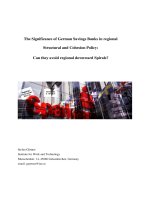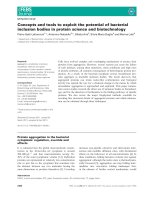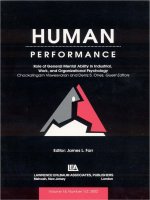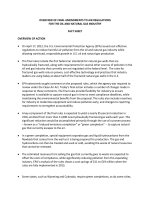EXAMINATION OF THE MARKETING ACTIVITY OF HUNGARIAN SMEs WORKING IN THE DAIRY AND MEAT PROCESSING INDUSTRY
Bạn đang xem bản rút gọn của tài liệu. Xem và tải ngay bản đầy đủ của tài liệu tại đây (410.55 KB, 37 trang )
PhD THESIS
University of Kaposvár
Faculty of Economic Science
Institute of Economics and Management
Department of Marketing and Trade
Head of Doctoral School:
DR. GÁBOR UDOVECZ
Doctor of the Hungarian Scientific Academy
Professor
Head of research:
DR. ZOLTÁN SZAKÁLY
Assistant professor
EXAMINATION OF THE MARKETING ACTIVITY OF
HUNGARIAN SMEs WORKING IN THE DAIRY AND MEAT
PROCESSING INDUSTRY
Author:
ZSOLT POLERECZKI
KAPOSVÁR
2011
CONTENT
1. BACKGROUND AND AIMS OF THE RESEARCH ........................... 3
1.1. Aims of the research ............................................................................ 4
2. MATERIALS AND METHODS ............................................................ 6
2.1. Secondary data collection ................................................................ 6
2.2. Primary data collection .................................................................... 6
2.3. Methods of analysis .......................................................................... 9
3. RESULTS ............................................................................................. 11
3.1. Marketing situation report on food industrial SMEs ................... 11
3.2. The appearing latent demand ........................................................ 14
3.3. The appearance of marketing-orientation .................................... 17
3.4. The logical structure of the marketing activity of food-industrial
small and medium size enterprises ................................................... 19
4. CONCLUSIONS ................................................................................... 24
5. NEW SCIENTIFIC RESULTS ............................................................ 26
6. PROPOSALS ........................................................................................ 29
7. PUBLICATIONS IN THE FIELD OF THE DISSERTATION ......... 31
1. BACKGROUND AND AIMS OF THE RESEARCH
Nowadays, the existence and the operation of small and medium size enterprises
(SME-s) is one of the most important questions of the Hungarian economic policy.
This sector gives the engine for economic development, the place where new and
innovative solutions are born and last but not least they employ the majority of
employees in countries with modern market economy at different rate in each
country. The SME sector is going through a turbulent transformation period in
Hungary, in which the stake is either to reach positions similar to those of the
western countries, or a full submission to the huge superiority of multinational
enterprises. Analyzing the situation of the two industrial branches (dairy industry
and meat industry), the future prospects based on our present knowledge can
obviously be outlined at first sight: the position of the small and medium size
enterprises sooner or later becomes impossible because of the huge import-dumping,
till finally they drop out of the market and only few enterprises producing very
special products will survive.
However, we should not forget that at present these enterprises are only studying
those sophisticated market mechanisms that have been used for decades or centuries
by the Western-European enterprises. The example of these enterprises shows that
these firms can operate in the big shade of big enterprises as well, and the sector of
small enterprises can be profitable in the long run by utilizing the adequate market
niches, interest enforcement methods and marketing sources. We should not be
afraid to study from the former practice of these countries because we could use
their experiences satisfactorily by adapting them to the Hungarian conditions. Our
neighbour’s, Austria’s case can be mentioned as an example, where the food
industry narrowly became a loser of EU-accession in the short run (TÖRZSÖK,
1998), because enterprises had to face a similar situation as the enterprises in our
country nowadays. However, applying the proper marketing tools the enterprises
operating in the Austrian food industry have become the beneficial owners of the
common market for today.
3
The aim of the dissertation is – by analyzing the marketing activity of the small
enterprises in the two branches of industry, and by analyzing the factors affecting it
– to contribute to the formation of the entrepreneurs’ attitude and to meet and
understand marketing as an effective instrument properly. Listing the primariness of
attitude in the first place is not accidental because in order to be able to use the wide
range of marketing tools it is necessary to understand their role and importance, and
to come clear with the benefits offered by them. This is why we have tried hard in
the dissertation and during its preparation to provide such material that is valuable
not only for scientific researchers working in this field, but for managers working in
practice as well.
Accordingly, the aim of the dissertation is to make the picture – which is dismal
at first sight – more tinged and to help create an alternative vision of the future using
the new information.
1.1. Aims of the research
Researches that test enterprises’ market orientation characteristically did not deal
with the specificity of food industry in Hungary, the existing surveys analysed it
independently from industrial branch and excluding almost all micro-enterprises and
a big part of small enterprises.
On the other hand, it has to be mentioned that food industrial marketing
researches are characteristically focusing on analysing the consumers’ behaviour.
This is why the aim of this dissertation to form a comprehensive picture that
introduces the marketing activity of food industrial small and medium size
enterprises in Hungary through the example of two sectors that are dairy and meat
industry.
The following concrete aims were drawn up within this general aim:
1) Meeting the factors influencing the marketing activity of Hungarian dairy and
meat industrial SMEs.
2) Analysis of the marketing mix elements of the examined enterprises.
4
3) Revealing groups of enterprises with the same behaviour.
4) Characterisation of each company group.
5) Creating a model that accounts for the marketing activity of food industrial
SMEs that can be tested extensively later.
6) Establishing marketing strategic proposals regarding the enterprises surveyed
based on secondary and primary results.
5
2. MATERIALS AND METHODS
The two fundamental methods of marketing research – primary and secondary data
collection - were used to collect results that are introduced in this dissertation.
2.1. Secondary data collection
We wanted to process all the available data of information sources during secondary
data collection that can offer relevant data in this topic. During secondary data
collection our aim was to map the results of researches investigating the marketing
activity of the Hungarian small and medium size enterprises theoretically
establishing the survey. Moreover, all of the international information was also
processed that might mean a useful example in Hungarian practice, and at the same
time that also contributes to the establishment of the theoretical background of the
research. To reach international special literature I have used the searchable online
databases of scientific professional articles, such as Science Direct, EISZ or
EBSCO. Moreover, I have reviewed several copies of journals published in printed
form as well as I have looked over books and statistical databases in the topic.
2.2. Primary data collection
Primary data collection can be separated into two phases: the phase of preparation
and quantitative data collection.
The questionnaire that is introduced in the dissertation was tested previously by
11 enterprises of the South-Transdanubian Region in 2005, then based on the
obtained experiences it was remodelled to the current, final form.
The field work of the national in-hall test was carried out in June and July in
2008 with the help of the countrywide network of Szocio-Gráf Market and Public
Research Institute seated in Pécs.
6
To fill in the questionnaires was the task of previously prepared questioners who
filled them personally with marketing leaders of enterprises, or if there were not any
with a leader of each enterprise who had full overlook to the whole activity of the
enterprise.
The determination of basic abundance’s consistence was prepared by KSH
(National Statistical Office) in December 31, 2005 according to the number of
categories and according to the register of sectors. According to this 1079
enterprises operated in Hungary belonging to the processing industry of these two
sectors. These enterprises meant the basic abundance of the research. We wanted to
ensure representativity regarding size-categories and the relation of the two sectors
in the survey. It caused serious problems that several enterprises rejected the
questionnaires and that the size of the basic abundance is very small, as well as, the
low number of enterprises that could be found in our database. These problems
caused that the respresentativity of the sample can be taken into consideration in
relation of the two sectors.
The basis of sample-forming was created with the help of a database that has
been received from a query of 1511, 1512, 1513 (meat processing) and 1551, 1552
(milk processing) TEÁOR* numbers – which occur in KSH’s fourth quarterly CÉGKÓD-TÁR publication of 2007 –, as well as on the basis of the size of enterprises.
This database contained data of 688 enterprises. Its random type was ensured with a
random number generator that helped choose enterprises from the database to get
into the inquiry. Table 1 contains the composition of the sample.
7
Table 1
Composition of the sample of research (db)
Industry
Meat
processing,
production of
meat products
Production of
dairy products
and ice creams
Altogether
0-9 heads 10-19 heads 20-49 heads 50-249 heads Altogether
27
14
20
15
76
9
1
3
7
20
36
15
23
22
96
The applied questionnaire can be separated into two blocks of questions that are
followed by background variables. Altogether 61 questions were put to respondents
and as a last group of questions statements were created, in which the agreement of
respondents were examined. This question-group helped form clusters. At the end of
the questionnaire 7 background variables took place.
Characteristically closed type questions were applied with two or more possible
answers. However, respondents were allowed to give opinions different from the
given ones in the “Others” answer-category. In the questions – where scales had to
be used – Likert scales expanding from 1 to 5 were applied in all cases. In these
scales only the first and the last points were named.
The first group of questions examined the information collection habits of the
respondents; the second one studied the presence of enterprise’s planning; the third
one considered the leading structure; the fourth one examined the expansion
conceptions and cooperation willingness of enterprises. The next four groups of
questions analysed the marketing tools according to the 4P. At the end of the
questionnaire – as a ninth question-group – 44 statements suitable to form took place
clusters. With these statements the respondents’ agreement was analysed.
The applied research method was chosen according to the methodology of the
Hungarian enterprise market-orientation researches.
8
2.3. Methods of analysis
The data received from the research were analysed with the help of SPSS 13.0
statistical software package.
Frequency superscripts from one variable statistical analyses, arithmetic average
from medium values, connected to this standard deviation (square average-mutation)
from deviation superscripts were applied (SAJTOS and MITEV, 2007; MOLNÁR,
2007). These methods are widely known and their application is a daily practice in
market research tasks, this is why we do not consider necessary to introduce them.
The questions’ connections with each other and with the background variables
were analysed in crosstabs, where the connection was evaluated with the help of
Pearson’s chi-square. In order to establish the tightness of the connection Cramertype V index was applied, because (at least) one of the examined variables is
measurable on at least one of the nominal scales.
During forming the factors I had the problem that the number of variables
involved in factor-analysis was hardly more than half of the element number of the
sample. Whereas, the acceptable ratio was at least triple. In order to eliminate this
problem the following procedure was used. As a first step – in order to determine the
number of factors – the factor-analysis was applied using all the variables. In the
course of this not only the factors with an own value above 1 were counted to be
usable, but the explaining values of each factor were also considered. So, the
number of usable factors was determined according to two point of views: on the
one hand, its own value had to be above 1, and on the other hand, it was considered
that involving another factor how much the whole explained variance got better. The
dividing line was drawn where the new factor did not improve the explained
variance significantly. Both point of views were realized in case of 4 factors, where
the whole explained variance was 78.3%.
After this it was examined that which variables were ranged by the program to
the factors received by Varimax-rotation and uncorrelated in pairs. In this way, four
variable-groups were received as a result of factor-analysis. In the next step the
factor-analyses was carried out only with variables belonging to one-one group. This
9
means that four different factor-analysis were carried out in the course of which at
most 24 variables were examined at the same time. In this way there is not a
contradiction between the number of variables involved into the factor-analysis and
the element number of the sample. As a final result of the factor-analysis carried out
in the groups, the strongest (the first) of the factors was saved in all cases. Thus, four
factors, not independent in pairs, were received, the explaining value of which is as
follows one by one: factor 1: 64.2%, factor 2: 62.2%, factor 3: 60.7%, factor 4:
60.4%.
In the next step cluster-analysis was carried out using the results of factoranalysis. This took place in two steps. First, in order to determine the ideal number
of clusters the so called Single Linkage was used from the hierarchical methods.
This is based on the principle of the nearest neighbour. So, first those two observed
elements get into one cluster between which the distance is the closest, then the
distances are recounted. The distance between two clusters is always determined by
the distance of the two closest points (SAJTOS and MITEV, 2007).
During forming the clusters a dilemma emerged according to which such a
cluster with low element number appeared that cannot be explained as a classic
cluster, much rather it got into a special group because of its considerable difference
from the average. In order to verify also in an alternative way the opportunities of
cluster-forming opposed to K-means method which is sensible to the element
number of the sample, the grouping was also carried out using hierarchical method.
But this brought the same result: analyzing the dendogram the groups with low
element number appeared already in the first step.
Three views were taken into consideration in the final determination of the
number of clusters. On the one hand, the sudden increase of the value found in the
coefficient column of the so-called Agglomeration Schedule received during the
hierarchical cluster-analysis, on the other hand, the dendogram, and finally, the
professional interpretability of the possible clusters.
10
3. RESULTS
The dissertation investigates the results of the research divided into two parts. In the
first part it analyses the enterprises of the two sectors involved into the research
together. In the second part the two sectors are analysed separately. The theses
summarize the main statements of the research carrying a message value.
3.1. Marketing situation report on food industrial SMEs
As an element of the examined enterprises’ information collection habits, I wanted
to know that in how big proportion the enterprises do market-research/data
collection activity. 69.8% of the respondents do some kind of information collection
in order to meet their potential target markets. This rate can be regarded quite
favourable until we take into consideration the channels used to get information,
which are summarized in Table 2.
Table 2
Information sources used to meet the potential target markets (N=67)*
Answer-category
Division of answers
Respondents
%
55
82,1
29
43,3
Acquaintanceship
Database, available in
public
Own research of
19
enterprises
Market-researcher
3
company
Others
3
* Respondents could give more than one answer
28,4
4,5
4,5
It can be seen that these information sources are suitable characteristically to get
knowledge about general market tendencies (acquaintanceship, public databases).
11
Those channels that could give concrete consumer information about the enterprises’
products (own research of enterprises, market research company) got rather back on
the list. According to this, the target market selection based on market information is
characteristic only 3.1% of the respondents. Nevertheless, the respondents judge the
level of information-supply sufficient.
Thus, it is not surprising that planned marketing activity is characteristic only a
very low rate. 29.2% of the respondents stated to make a marketing plan, which
seems a good rate at first. The examination of the further elements of the group of
questions focusing on planning got more and more detailed, e.g.: presence of
marketing budget, its controlling and lifecycle analyses. The former determined
number began to decrease seriously after the detail questions. Only 15.6% of them
have a marketing budget, which is controlled regularly by 14.6% of them (the way
of control is not mentioned yet), and only 9.4% follow and evaluate their products’
lifecycle. So the former 29.2% pretty much decreased as the questions got more
detailed.
These results forecast the level of the enterprises’ marketing knowledge. One
element of the question-group examining the management of the company searched
its source. Table 3 contains the results of this question-group.
Table 3
Source of marketing knowledge (N=96)*
Answer-category
From experiences in the course of business
From journals and special books
From participation in professional conferences
The enterprise has a leader with marketing qualification
Others
* Respondents could give more than one answer
Division of answers
Respondents %
76
79,2
13
13,5
10
10,4
9
9,4
3
3,1
Probably the following tendency can be found in the background of the not too
favourable results concerning the situation of marketing: enterprises consider the
12
experiences obtained in the course of business satisfactory for marketing activity. A
question arises here: what kind of knowledge these enterprises can receive from
each other if none of them have marketing knowledge? Altogether 9.4% of the
enterprises have a colleague with – in most cases medium level – marketing
qualification.
Analysing product-policy, it has been found that the examined enterprises try to
compete on the market with their products’ good quality. However, they do not
possess any information about their consumer judgement. The product‘s pretended
consumer judgement coincides with the respondents’ admittedly own opinion in this
question. Moreover, they are convinced that the product’s quality would be the most
important factor of competition in food industry nowadays, with an average rate of
only 3,64 on a one to five scale. Some 65.6% of the respondents deal with the
production of mass products that provide the majority of their income.
Analysing price-strategy together with product-policy it can be proved that the
enterprises believe that the basis for positioning obviously is in the dimension of
lower price and good quality. The basis of the respondents’ pricing is formed by
firstly, the consumers’ acknowledged market value, secondly, by the production
costs and thirdly, by the profit maximization. Among pricing point of views there
was not observed any consideration resulting from marketing aims (e.g. positioning
considerations).
Enterprises do not carry out conscious channel-policy: 60.4% of the respondents
do not select their markets, they try to be present everywhere where they can. 58.3%
of the respondents use a channel with one or two elements in order to pass their
products to consumers, but in spite of this, the average rate for this question is 3,47
on a one to five scale (“1” means “I cannot follow at all” and “5” means “I am
completely able to follow it”).
An important character of their communication is that 53.1% of them do not
possess a brand-name. Those who do some kind of planned communication,
characteristically target the final users, and they target intermediate persons at a
lower rate, or a group with 15.6% of respondents wants to send messages to both
groups. The characteristic applied tools are consumption inspiration and direct
13
selling, while intermediate persons are mostly motivated with gifts. Both
communication forms are done at low intensity.
3.2. The appearing latent demand
Several Hungarian researches (SAJTOS, 2004; SZABÓ, 2009; POLERECZKI and
SZABÓ 2005; JÓZSA, 2004) show the same unfavourable picture analysing the
small enterprises’ marketing activity as the above mentioned situation. A question
arises here whether the judgement of marketing as a tool is so really unfavourable
among Hungarian small enterprises or not. In order to give an answer we had better
analyse what companies think about future, which fields they expect development
in.
NYERS and SZABÓ in 2003 asked enterprises in their survey about which
fields they see the main future success-factors. The answers are shown in Table 4.
Table 4
The main success-factors determined by SMEs
Main success-factor
Better service of clients’ needs
Occupation of new markets
Introduction of international quality assurance
Forming individual markets
Introduction of a new product or service
Improvement of employees’ qualification
Introduction of modern information system
Developing new technology
Development of cooperation
Service providing
Opening export-markets
Source: NYERS and SZABÓ, 2003
The rate of high (5)
agreement
Firms in
Firms in
foreign
Hungarian
property
property
39,3
44,8
26,2
26,3
31,1
24,3
13,1
16,2
21,3
15,1
9,8
13,7
13,1
12,9
8,2
11,7
13,1
11,5
16,4
10,3
11,5
8,1
If we examine the answers written in bold letter in Table 4, then we can see that
respondents named fields in big proportion that are in strict connection with
14
marketing. Forming new markets, better understanding of the clients’ needs,
creating individual (niche) markets are all tasks that can be developed classically
with the help of marketing tools.
The results of our research also show a similar tendency. The results that can be
seen in Table 5 show the respondents’ ideas about future development. The
respondents also named several fields that can be covered with marketing tools in
big proportion, such as extension of the group of clients, or product-innovation.
Table 5
Possible future development directions according to respondents (N=96)*
Answer-category
Division of answers
Respondents
%
45
46,9
26
27,1
Extension of the group of clients
Product-innovation in the field of
mass-products
Product-innovation on the market of
26
niche-market products
Development of marketing activity
10
Forming horizontal integrations
5
Forming vertical integrations
2
Other
4
* Respondents could choose from more than one answer
27,1
10,4
5,2
2,1
4,2
In another question respondents stated that they would be able to make an
acceptable profit by an average of 18.23% price level increase. The tools of reaching
a higher price level according to enterprises are summarized in Table 6.
Table 6
15
The tools of reaching a higher price level according to respondents (N=96)*
Answer-group
Division of answers
Respondents
%
36
37,5
27
28,1
Development of connection system
Product-innovation on the market of nichemarket products
Product-innovation in the field of mass22
products
Development of marketing activity
11
Horizontal cooperation with other processors
10
Application of brand-names
6
Vertical cooperation
3
Others
10
* Respondents could choose from more than one answer
22,9
11,5
10,4
6,3
3,1
10,4
The fields that also need an important marketing activity were also emphasised
in this case.
Another important aspect of the results is that respondents ranked marketing
activity behind in both Table 5 and Table 6 only about 10-11% of them think it
could be important in the future. It can be stated that enterprises do not consider
marketing a key-factor from the point of view of their future, but at the same time
they name such directions important that belong definitely to this field.
The apparent contradiction can be resolved as follows. It is well known that
these enterprises’ real marketing knowledge is very low. In other words we can say
that these enterprises do not really know what activities marketing really contains. In
spite of this, they instinctively see their way out of this more and more difficult
market fight in such fields that are in strong connection with marketing. This is
nothing else but a latent demand for an effective marketing activity present in
enterprises.
At this point it is worth mentioning the work of CHIKÁN and CZAKÓ (2002)
in which they explain that the position of marketing has become stronger in
enterprises during the past few years, but at the same time it is well behind the level
of western countries. According to the results of ACHROL and KOTLER (1999)
this tendency can be reckoned as natural because it is observed in their research that
16
the marketing-orientation of enterprises operating under hard competition conditions
was getting stronger. So enterprises exposed to hard competition consider marketing
more and more as a strategic tool. It can be concluded that with a stronger
competition in Hungary a stronger marketing-orientation can be expected.
It can be stated that with a fiercer market competition among the investigated
enterprises such field are expected to develop in the future that might lead to an
improvement in their marketing orientation in the future.
3.3. The appearance of marketing-orientation
In the next step a question arises: if this latent demand really exists among the
analysed enterprises then does it appear at the level of real activity and can it be
identified.
In order to clear up this question, factor- and cluster-analyses (K-means) were
carried out on the basis of agreement of 44 statements appearing at the end of the
questionnaire regarding the enterprise’s way of thinking and activity. The results of
research showed the following: 4 different characteristic behaviour-models
succeeded to be identified during factor-analysis among which the marketingoriented way of thinking could already be found. These are those who consider it
necessary to pay emphasised attention to understanding the consumers’ needs. They
try to form product features according to these needs at an economically justifiable
level considering point of views of sustainability. However, it has to be noted that
this factor could barely be identified.
In the next step cluster-analysis was carried out on the basis of factors. Four
characteristic behaviour-groups were identified. Firstly, the cluster with “C” sign
was called as the group of “careful price competitors”, those who believe that the
main instrument to reach market advantage is the lower price. Therefore in the
future they want to focus on improving productivity and widening distribution.
The following “E” cluster are the “relationship oriented”, who extraordinarily
agree with the statements regarding the importance of internal and external
relationships.
17
Several contradictions were revealed in case of the third “F” group called
“strugglers with contradictions”. Probably due to this inside tension a successful
enterprise group with full of contradictions is outlined, which, due to these
disorders, looks into the future with fears.
The fourth “G” group can be called as “improving optimists”. They also
believe in the importance of relationships. The key of market success are the
stressed consumer orientation, and beside it, the infrastructural background of the
company.
It can be seen from the results that none of cluster groups are characteristically
marketing-oriented. The presence of marketing could be found only in one group,
but even there marketing got a very subordinated and executive function with no
noticeable effect on the enterprise’s strategy. So, the presence at the level of factors,
as we expected, cannot complete itself in forming a group with characteristic
behaviour.
Although marketing-oriented way of thinking could not be proved at the level of
enterprise cluster, a further examination was carried out in order to try to find an
enterprise group with marketing-oriented attitudes. For this reason four fields were
stressed from the question block connected to marketing information-collection and
marketing planning. Answers given to these questions gave the basis of determining
sufficient marketing activity. These four fields are the following: market information
collection serving the basis for product-features, an existing marketing plan with
own budget, control of amounts spent on marketing as well as analysis and use of
product life cycle. Thus, the rate of enterprises that carry out market information
collection as a basis of marketing planning for concrete products, which possess
formerly determined own marketing budget, which control the utilization of this
money, and which set their planning to the current life cycle of their
products/product-groups figures out 2.3% of the whole sample. This rate increases
to 8.3% in case the proper operation of three of the listed four elements is considered
sufficient.
Testing these enterprises regarding the enterprise size two poles can be found.
Their common feature is that all but one of them belong to meat industry and all of
18
them operate in the form of an Ltd., as well as they do not show local uniformity. A
smaller group of them belong to small enterprises with between 0-20 employees and
maximum Ft 250 M net income. Enterprises with 20-100 employees and more than
Ft 750 M net income form a bigger part. These are the firms that can be called
innovators – to the example of consumer novelty acceptance – in the examined
group of small enterprises.
According to the results it can be stated that the marketing-oriented way of
thinking already exists among the enterprises of both examined industries, although,
it has only small effect on SMEs operating in the sectors.
3.4. The logical structure of the marketing activity of food-industrial small and
medium size enterprises
It is important to analyse what kind of factors have an effect on the development of
the marketing activity in the examined group of enterprises in order to present the
logical system of the results that came to the light during the research.
For this, external and internal elements determining the marketing activity of
food industrial SME sector (Figure 1) were summarized in a logical frame. During
creating this we disregarded describing those elements that mean external
features/environment. Its aim was to understand what external stimulus means to the
enterprise, as well as to present the connections between internal processes.
My approach is basically divided into two main levels: the first is the place of
marketing as enterprise philosophy in the management’s way of thinking; the second
is the enterprise’s function role originating from the enterprise’s operation.
In the first level, the leader of the enterprise has a determining influence on the
enterprise’s philosophy approach of marketing. Basically, the owner or owners
unanimously and exclusively determine(s) the effect of consumer-oriented way of
thinking on the enterprise characteristically because of the family ownership. The
judgement of this group of owners determines the employed leaders’ and
subordinates’ opinions about marketing. If the owner group is committed to
marketing as an enterprise’s leading philosophy, then it influences the whole
19
enterprise. In SME sector the management and the owners are usually the same,
which makes their central role clear. These two statuses are basically separated in
the case of big companies. In this way, the different way of thinking of these two
groups influences the whole organization in different ways.
.
20
INDUSTRIAL ENVIRONMENT, CONSUMER PREFERENCES
Level of
marketing
as a
corporate
philosophy
Ability of
setting up
strategies
Level of
marketing as
an
independent
corporate
function
Owner
The corporate judgement on marketing
Experienced
workforce
The practise of
Information
intelligence
Corporal
vision and
long term
marketing
strategy
Independent
marketing
budget
Ability of
working out
marketing
tactics and
execution
Independent decision making
Supervision
Executed and
modified
marketing
strategy based
on the
experiences
Figure 1.: Logical frame of marketing activity of the SMEs working in the food industry
21
Marketing as an independent corporate function can be found on the next
level. In case leaders committed to marketing were found on the previous level, then
on this level a strong marketing function can be found.
Two different factor groups can be separated on the level of corporate
function. One of them are the factors that determine the strategy building abilities of
the SMEs. These are the existence of experienced workforce, the information
collection practice and the independent marketing budget, the creation of which is
based on market goals. These three factors jointly affect the level of the marketing
strategy ability of the enterprise, on the other hand, the experienced workforce has
an outstanding importance. An organized marketing activity could be found in case
of SMEs that were in possession of this factor.
The previously introduced two levels – a committed management to marketing
as a corporate philosophy and a strategy making ability – can jointly result in the
creation of marketing strategy in harmony with the enterprise aims and the ability of
long term planning, which are the results of the process.
The second field of the functional level is the execution. It includes two
factors: one of them is the independent decision making and the other is the claim to
supervise the marketing budget efficiency.
The presence or the lack of independent decision making can fundamentally
influence the execution success. In case the responsible leader of the execution of
the formerly created marketing strategy has the right to make independent decisions,
then it can contribute to its success.
An astonishing result of the research is that the frequency of the supervision is
really low among the examined enterprises even if they have planned marketing
budget and a marketing plan. The satisfactory level of supervision creates the
conditions for the control of the marketing strategy. There is not a planned
marketing activity without it.
If this level works satisfactorily then a marketing strategy realized effectively
and modified based on the results can be created, which can be defined as the output
of the effective operation of the three described levels. In this case we can talk about
a dynamic marketing plan that continuously adapts to the changes of the
22
environment and which takes long term strategic aims into consideration as well.
The dynamic character of planning is ensured by the presence of the feedback.
23
4. CONCLUSIONS
According to the results information collection pertaining to the general market
tendencies is typical of the respondents, and few of them have particular information
about their own product. Otherwise they believe that their market research activity is
at the required level. It shows that they do not perceive the lack of information and it
is not believed as an obstacle from the view of their market success.
Therefore the presence of marketing planning is low in the sample, on the
other hand, it is not linked to budget and subsequent supervision. The tested
enterprises usually do not have an employee with marketing qualification, therefore
there is not a permanently responsible person for the marketing activities. This kind
of behaviour is behind the lack of strategic approach. It causes the disability of
setting up long term conceptions. It also results in the low marketing efficiency even
among companies that have some kind of planned marketing activity.
An overwhelming majority of the companies believe that the way to future is
the improvement of mass products, on the other hand, more and more of them want
to produce special products as well. It is mainly caused by the lack of alternative
future perspectives, which is due to the lack of information about the consumer
demands, and the production and sale oriented approach. They do not have the
abilities to plan the company’s activities on a consumer oriented way, or to reach the
target groups effectively, and no more than 8,3% of them have the adequate
marketing skills. It means that a marketing oriented way of thinking can be
measured among the factors, on the other hand, at the same time it is characteristic
of such a few enterprises that an independent behaviour group (cluster) cannot be
found. It also means that a market oriented way of thinking is getting stronger
among SMEs in the food industry, which is defined as one of the side effects of
stronger market competition by the literature.
Their product policy focuses on producing mass products, which is linked to a
lower price position. 72,9% of them are able to make profit at present prices, but
they would like an average price rise of 16,7%.
24
The classical channels (retail trade, wholesale trade, HORECA) dominate their
sales. Their communication is accidental and the market position of their products is
the lower price-proper quality. 53,1% of them do not have an own brand-name and
60,4% of them have no web page. Their communication strategy is built up
according to the pull strategy, therefore the target of their messages are the final
consumers, on the other hand, the push strategy is less wide-spread. It can be stated
that the push strategy is more useful for them regarding the characteristics of their
products and the features of these two strategic options.
Four different clusters were found during the research. They are the careful
price-competitors, the relation oriented, those affected by contradictions and the
developing optimists. The examination of their characteristics supported the fact that
marketing as a corporate philosophy cannot be found among the tested companies.
The highly developed idea considers marketing as an executive function, on the
other hand, it has no effect on the company’s way of thinking.
25









